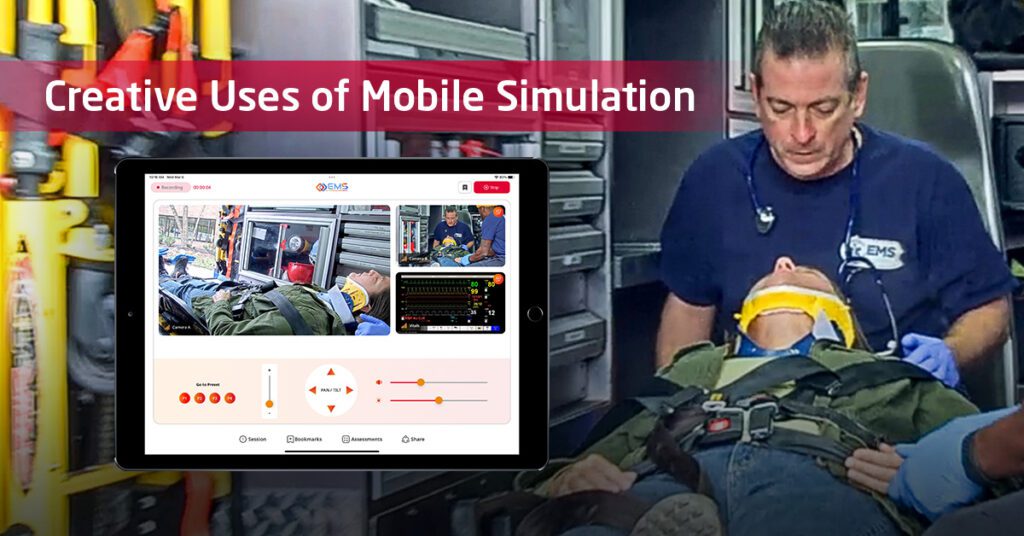Mobile simulation training is transforming healthcare education in unimaginable ways than just a few years ago. Picture this: Rather than being confined to dedicated simulation labs, today’s healthcare training can be replicated anywhere—on the battlefield, in an ambulance, or even in a patient’s home.
This doesn’t just make training more accessible, it better prepares learners for the challenges they will face by immersing them in the unpredictable environments where they will practice, effectively bridging the gap between theoretical learning and real-world application.
Here, we explore eight innovative uses for mobile simulation training in healthcare, showcasing its versatility and effectiveness.
1. In Situ Simulation Training
Healthcare education programs can employ mobile sim units to conduct on-site training in clinical environments such as emergency rooms and hospital hallways. Mobile simulation software and tools enable educators and future healthcare practitioners alike to:
- Identify and address process and skills gaps
- Fulfill continuing education requirements
- Refine their approach and technique
Running simulations in situ exposes future practitioners to realistic hospital settings, enhancing their preparedness for real-life medical situations.
2. Field Training for Combat Medics
Delivering life-saving treatment amidst the chaos and horror of the battlefield requires quick thinking and nerves of steel. Unsurprisingly, traditional simulation training falls short in preparing inexperienced combat medics for these high-stress environments.
Fortunately, the current generation of mobile simulation training makes it possible to offer realistic field exercises that replicate emergency situations in combat zones or during transport. This type of immersive training hones quick decision-making skills and builds the confidence needed to perform under extreme pressure, ensuring medics are ready to provide critical care at a moment’s notice.
3. EMT Training in Non-Traditional Spaces
For EMTs, no two calls are the same. One day, you might be treating a patient in a cramped apartment, the next, responding to an accident on a busy highway.
Mobile simulation training allows future and current EMTs to practice in non-traditional spaces, such as ambulances or various real-world environments. By training in actual environments in which EMTs will work, they can better understand the spatial constraints, equipment, and logistics challenges they will encounter, improving their efficiency and effectiveness during emergencies.
4. Continuing Professional Development
Regular continuing education (CE) is necessary for many healthcare facilities to deliver the best possible care, maintain professional licenses and designations, and fulfill partnership requirements. In today’s hyper-competitive job market, employers are finding that robust CE programs make for a competitive employee perk.
Hospital education programs can support continuous professional development by bringing mobile simulation units directly to healthcare facilities while keeping healthcare providers up-to-date with evolving medical techniques and technologies. Mobile units enable hospitals to conduct regular training sessions, ensuring staff are consistently improving their skills and knowledge.
5. Public Health Emergencies and Interdisciplinary Training
During public health emergencies, effective response requires seamless coordination among various entities and agencies—hospitals, emergency services, police departments, public health agencies, etc. Mobile simulation supports this by facilitating training with multiple entities in their native locations, enabling participants to practice together in realistic scenarios.
By conducting interdisciplinary training sessions with advanced mobile simulation technology that can be employed almost anywhere, at any time, healthcare and emergency services teams can streamline their communication and response strategies. Whether preparing for a natural disaster or an infectious disease outbreak, these tailored training sessions ensure every player is well-prepared to handle the complexities of public health emergencies.
6. Just-in-Time Training
Implementing mobile simulations as refreshers for practitioners who are about to engage in specialized procedures or use new equipment ensures that skills are sharp and up to date. This just-in-time training is invaluable for quick, effective skill reinforcement, enabling healthcare providers to perform complex procedures with confidence and precision.
Whether it’s mastering a new surgical technique or familiarizing oneself with the latest medical devices, mobile simulations provide immediate, hands-on practice. Additionally, this targeted approach helps mitigate risks stemming from procedural errors and, in the process, enhances overall patient safety.
7. Targeted Skill Station Camps
Traveling skill stations set up at conferences or healthcare institutions provide practitioners with hands-on practice of specific skills, such as advanced life support techniques and surgical procedures. These targeted skill camps offer intensive, focused training essential for mastering complex medical procedures. And by bringing these opportunities directly to convenient locations, mobile simulation helps reduce travel costs and time and ensures that care providers in remote areas have opportunities to upskill.
These skill stations can be customized to meet the specific needs of different medical disciplines, offering everything from basic skills refreshers to advanced procedural training. This ensures practitioners receive relevant training that directly applies to their practice areas while fostering a collaborative learning environment.
8. Home Health Care Scenarios
Simulating in-home care environments prepares trainees for the unique challenges of providing patient care outside traditional medical facilities. This equips healthcare providers with the skills needed to deliver effective care in patients’ homes, addressing the growing demand for home health services.
Mobile simulation can recreate home care settings’ diverse and unpredictable nature, helping providers adapt to different environments and patient needs.
Enhancing Healthcare Education through Mobile Simulation Training Technology
Education Management Solutions’ (EMS) Training in Motion solutions are ideal for implementing these and many more mobile simulation training scenarios. From enhancing the realism and efficacy of training to tracking and evaluating skills competency to integrating into learning management systems, Training in Motion empowers educators, students, and practicing professionals to take their skills to the next level.
Learn more about how EMS can support your mobile simulation training needs now.

